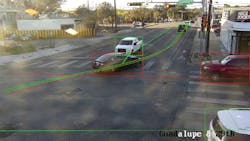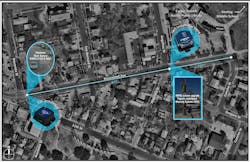Pilot programs in Austin, Texas leveraging technology to meet Vision Zero goals
A host of pilot programs underway in Austin, Texas, aim to improve roadway safety by leveraging high- and low- technology solutions. They are part of an effort to help Austin reach its goal of zero serious injuries and fatalities on the roadway—an initiative known as Vision Zero.
Last month, TAPCO deployed technology in Austin to test their Connected Vehicle Pedestrian Crosswalk Warning System. This pilot will test the system’s ability to improve pedestrian safety by informing drivers when they are approaching pedestrians who are crossing the street. When the crosswalk’s push-button is activated, the system will send communications to nearby connected vehicles that pedestrians are present and crossing the street in their intended path. Connected vehicles have the ability to use this wireless technology to communicate with infrastructure and other vehicles, and their features include displaying basic safety messages to drivers. The system also provides warnings to drivers of non-connected vehicles using highly visible, rectangular rapid flashing beacons on both sides of the road.
TAPCO’s pilot will evaluate the system’s ability to enhance safety on Austin’s roadways and mid-block crosswalks. According to the National Highway Traffic Safety Administration in 2019, 6,205 pedestrians died in vehicle-related crashes. Mid-block crosswalk systems have shown to significantly increase driver yield rates. Because of this, the Vision Zero program has heavily invested in and deployed midblock crosswalks systems across Austin. This pilot will also help the city develop a process for retrofitting older infrastructure with the new connected vehicle technology.
3M and MicroTraffic have developed an artificial intelligence near-miss detection system to assess risks and proactively identify opportunities for intersection safety improvements. During the first phase of the pilot, 3M and MicroTraffic measured near-miss incidents at selected intersections across Austin to proactively identify opportunities for safety improvements. Near misses included potential incidents between vehicles or involving vulnerable road users like pedestrians, cyclists, and e-scooter riders. Based on the detected risks and data gathered, 3M and MicroTraffic provided recommendations for low-cost safety improvements—like high-visibility reflective treatments around traffic signals and on crosswalk markings—for each intersection. After the low-cost safety improvements were implemented, another round of data will be captured to determine how productive these countermeasures were in preventing incidents. Intersection safety analytic pilots like this ensure that the City of Austin remains an early adopter of innovation that can eliminate all serious injuries and fatal crashes on its streets.
Recently, the Smart Mobility Office partnered with Velodyne Lidar to test their lidar-based solution. Velodyne’s solution uses Lidar, which stands for Light Detection and Ranging, as a method to detect all road users including vehicles, pedestrians, and cyclists in real time. Velodyne’s Intelligent Infrastructure Solution will monitor traffic data at East 7th and Springdale and provide categorized monitoring data on pedestrians, cyclists, cars, and trucks. This intersection has also been identified in the High-Injury Network (HIN), which identifies streets in Austin with a relatively high number of serious injury and fatal crashes. The HIN is used to identify locations where engineering, education, or enforcement interventions should be prioritized to have the most impact in improving safety. Austin Transportation is interested in Lidar-based solutions because of the technology’s potential to protect personal identifiable information while still helping the Department collect important traffic data that will help the city achieve its Vision Zero goals.
TAPCO, Velodyne, 3M, and MicroTraffic are all partnering with Austin Transportation’s Smart Mobility Office to test their technologies. All three of these pilots will produce information that could help shape policy, educational programs, or changes to the city’s infrastructure that will help Austin reach its Vision Zero goals. The city believes data-driven solutions like these pilots can lead to improved safety outcomes.


